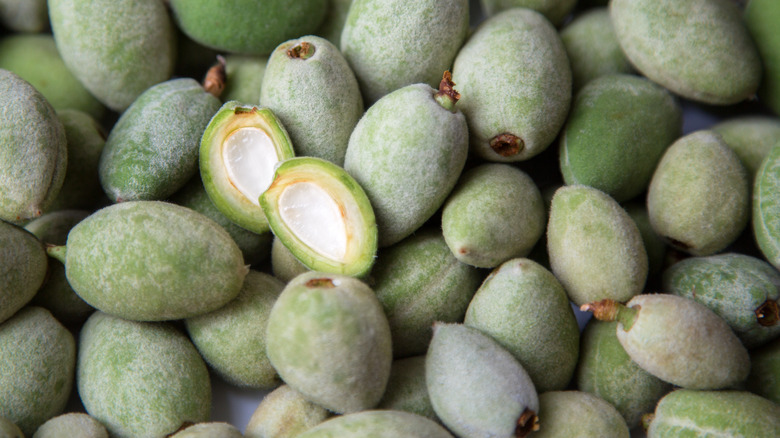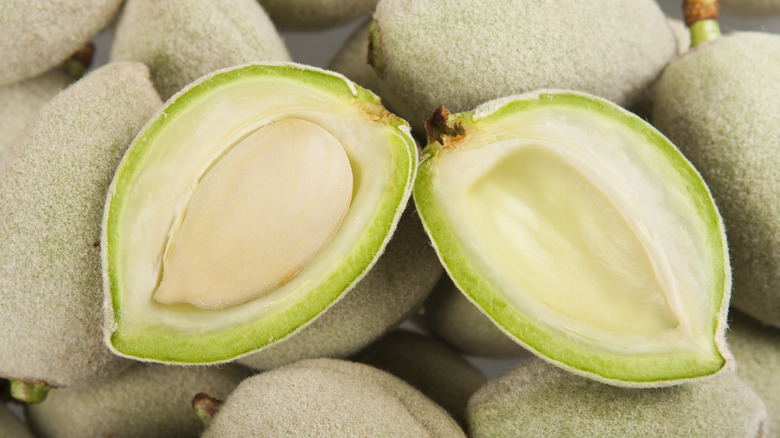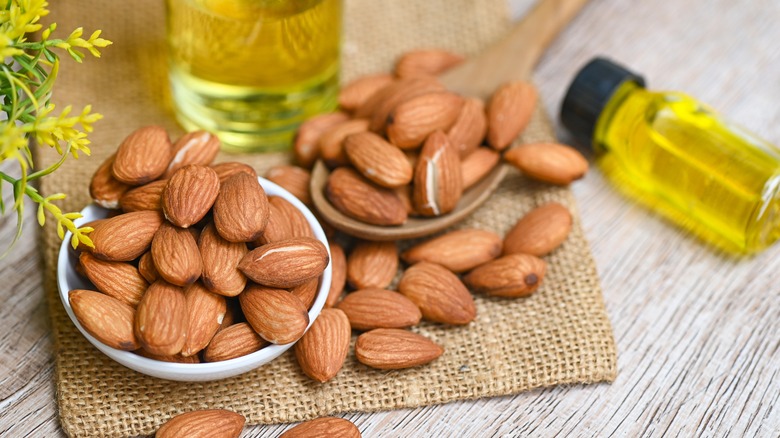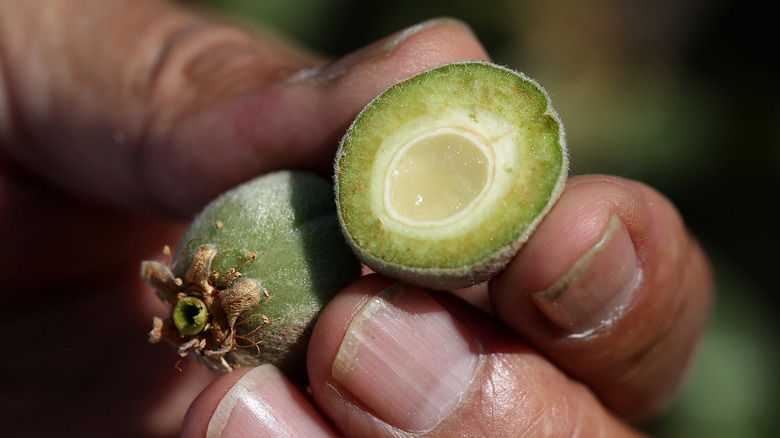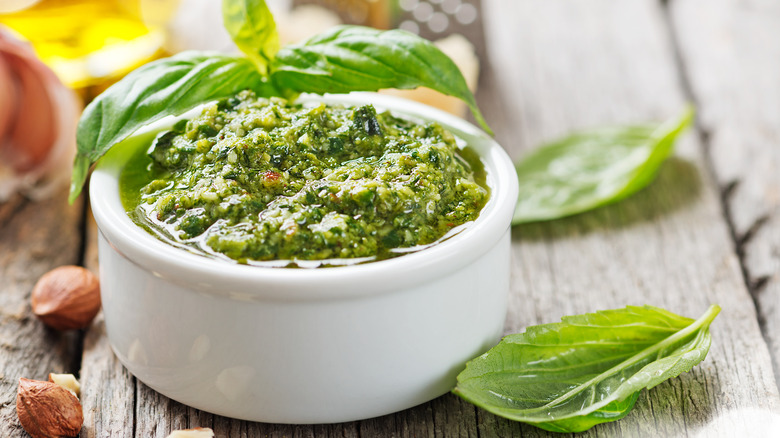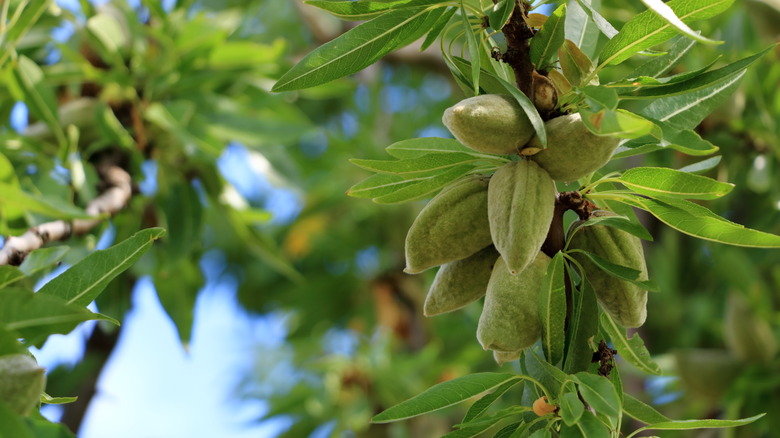When Are Green Almonds In Season And What Are They Best Used For?
Green foods like pesto, arugula, and Shamrock shakes evoke the feeling of spring, but you may have never heard of this lesser-known one: green almonds (Prunus dulcis). These little nuts are only in season from April to May, so if you blink, you might miss them — but it's worth keeping track of when and where you can find them. In fact, they're considered by some chefs and consumers alike to be a rare delicacy, which isn't a surprise once you get a look at their unique outer appearance.
You can eat them just like you would regular almonds: with desserts, on a charcuterie board, or in salads. Since they're in season in the spring, they pair well with other fresh veggies like peas, asparagus, and lettuce. To maximize their flavor the most, eat them by the handful with a little dash of sea salt or sugar. Although they technically are almonds, you'll instantly realize that their taste and texture are vastly different from the brown nuts you're used to.
What are green almonds?
Green almonds are the same thing as regular almonds — they're just the unripe version. They're part of the Rosaceae family, making them a close relative of blackberries, raspberries, apples, cherries, and a plethora of other fruits. Although these green nuts may be a novelty to some, they've been used all across the world throughout history.
Ancient religious paintings and stained glass windows feature halos that look like green almond halves, which are called "mandorla" in Italian. In the Middle East, they're traditionally eaten on top of salads or ice cream and are sometimes ground into a paste. In the U.S., these nuts primarily come from California, along with most of the country's almond supply.
Unlike fully ripe almonds, the young versions are a light pale green, fuzzy on the outside (which makes sense considering they're close relatives of peaches), and tender on the inside. They also are too young to have skin, but they have the same shape as the brown nuts we're used to: small, oval, and approximately two inches long. And although we typically call them nuts, almonds are actually stone fruits, which is just another way they're similar to peaches.
Green almonds vs. dry almonds
Dry almonds, also known as mature almonds, are the nuts we're used to eating after they've been left on the tree long enough to fully grow. They have a hard exterior and a dry brown shell that can turn bitter when they get older, unlike the soft, fuzzy, sweeter outside of the green version. Since almonds are stone fruits, the mature nuts we typically eat are technically the seeds found within the fruit.
The flavor of younger almonds is much different than the older ones, and it's typically sweeter and not as strong. While their nutritional content is pretty similar, green almonds have three times as much thiamin as mature ones and lack the small amounts of acrylamide found in dry ones. If you're unfamiliar, acrylamide is a substance thought to be a carcinogen in high quantities (via the U.S. Food & Drug Administration).
And while green almonds have a quick growing season, the fully mature nuts are in season from August to October. By then, the younger fruits have dried, hardened, and split open, revealing the nuts we commonly consume here in the U.S.
What do green almonds taste like?
Green almonds still have that almond flavor, but it's lighter and more subtle than the dry version of the nuts. They taste a little sweet and a little sour and have springy floral and grassy notes, making them a tasty accompaniment to other ingredients in season then. Their texture is perhaps what separates them from dry almonds the most, however. The younger versions have that fuzzy skin and a soft, jelly-like texture with just a little firmness, comparable to a grape. When they're really young, the fruits are see-through, and they turn more and more opaque as they grow up.
Because of their unique texture, these green fruits are consumed a little differently than typical almonds. It's completely possible to eat them whole, but some think the shell is too bitter to eat, so you can also gently cut them open. The tender seed inside, which is where most of the tangy flavor is, can be popped out and eaten on its own.
How to cook with green almonds
While green almonds are fun to eat by the handful, feel free to get creative with them in a variety of sweet and savory recipes. You can chop them up and add them into salsas, sauces, chutneys, or relish, where they'll add a little sweetness, tang, and earthiness. They're also soft enough that pickling the fruits is a popular way to eat them. After slicing them in half, you would stuff them in a jar with vinegar, water, honey, herbs, and spices like dill and peppercorns. It's also common to poach them in olive oil and sprinkle herbs on top.
When chopped, you can also use these green fruits to top pastas, soups, salads, and stews. They're particularly popular in Khorest-eh Chagaleh Badam, or green almond stew, a Persian dish that includes beef, parsley, and mint. But savory meals aren't the only way to enjoy them — they're also ideal as toppings for desserts like frozen yogurt, tarts, and ice cream or in a bowl with a sweet cheese like mascarpone or ricotta. You can even make almond milk out of green almonds, as long as you get nuts that are a little on the older side.
Where to buy green almonds
If you live in California, you may be able to find green almonds at grocery stores and farmers markets since they are commonly grown there. On the East Coast, however, you may be able to track them down in specialty food stores like Eataly or Dean and Deluca. If you don't live near any of these places, they're also abundantly found online. Websites like Stewart & Jasper Orchards sell the nuts in their first, second, and third stages of growth — but they're only available for eight weeks out of the year and sell out quickly, so order them while you can. You may also be able to purchase them at some major retailers like Walmart.
Once you get your hands on some green almonds, it's important to eat them as soon as possible. They only remain in pristine condition for a few days in the fridge, after which they start turning bitter, although they'll technically last for up to three weeks. And when buying the nuts, make sure they're soft and green with their signature fuzzy skin. If you're purchasing some that have started turning hard and dry, they've moved past their prime green phase.
Nutritional information about green almonds
While green almonds have more thiamin than the dry version, they essentially have the same nutritional value as regular almonds otherwise. These nuts are full of fiber, protein, and "good" fat, along with valuable vitamins and minerals like vitamin E, manganese, magnesium, riboflavin, phosphorus, and copper. They pack in a plethora of health benefits, including helping to lower "bad" cholesterol (low-density lipoprotein) and raise the "good" kind (high-density lipoprotein), according to WebMD.
Almonds also help to build muscles, promote heart and gut health, and reduce the risk of heart disease, per Everyday Health. They also may help protect against oxidative stress, and the vitamin E may help ward off oxidative damage in addition to lowering chances of contracting Alzheimer's disease and cancer, Healthline explains. And as celebrity nutritionist Nmami Agarwal told NDTV Food, these green fruits are extremely beneficial for bone health, and they may even help promote healthy skin and hair.
If you have a nut allergy, however, you should stay away from green almonds just like you would with any other nut.
